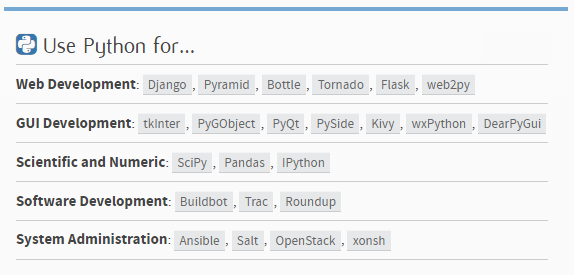A programming tool for scientists
Despite the fact that its name originally comes from the Monty Python comedy group, Python is a serious programming language that has gained immense popularity during last decade, as indicated by the TIOBE index.

Python’s simplicity, versatility, strong community support, and extensive ecosystem contribute to its success and widespread adoption in the software development industry.

Fig. 1 From the python.org website.
Benefits of the Python language
Python has gained immense popularity for several reasons:
Simplicity and Readability: Python’s syntax is clear, concise, and easy to understand, making it accessible to beginners and experienced programmers alike. Its clean and readable code enhances productivity and reduces the time required for development.
Versatility: Python is a versatile language that can be used for a wide range of applications, including web development, data analysis, artificial intelligence, scientific computing, automation, and more. Its extensive standard library and third-party packages provide solutions for various tasks, making it suitable for diverse projects.
Large Community and Ecosystem: Python has a large and active community of developers, educators, and enthusiasts who contribute to its growth and support. The extensive ecosystem of libraries, frameworks, and tools built around Python enhances its capabilities and accelerates development.
High-Level Language: Python is a high-level language with automatic memory management and dynamic typing, which simplifies programming tasks and reduces the complexity of code. Its interpreted nature allows for rapid prototyping and iterative development.
Strong Industry Adoption: Python is widely adopted across industries, including technology, finance, healthcare, education, and more. Its versatility, ease of use, and robustness make it a preferred choice for developing software solutions in various domains.
Support for Data Science and Machine Learning: Python has become the de facto language for data science, machine learning, and artificial intelligence due to its rich ecosystem of libraries such as NumPy, pandas, TensorFlow, and scikit-learn. Its ease of integration with other tools and frameworks simplifies the development of complex data-driven applications.
Cross-Platform Compatibility: Python is a cross-platform language, meaning that code written in Python can run on different operating systems without modification. This flexibility makes it an ideal choice for developing cross-platform applications and ensures portability across different environments.
Overall, Python’s simplicity, versatility, strong community support, and extensive ecosystem contribute to its success and widespread adoption in the software development industry.
Comparison to other languages
There is two main categories of programming languages:
compiled languages, such as C/C++, Rust or Go: They are translated entirely into machine code before execution. Source code is transformed into machine code by a compiler during a separate compilation step.
interpreted languages, such as Python, JavaScript or Ruby: They are executed line by line at runtime. Source code is directly translated into machine code by an interpreter during execution.
C/C++
These compiled languages are very fast, because the source code is already in machine code form.
But, they often have stricter syntax requirements and longer development cycles. These are difficult languages for non programmers.
Note
Most methods provided in Python modules (such as NumPy or Matplotlib) are precompiled in a C or C++-like language to gain execution speed. Therefore, it is often preferable to use existing libraries rather than creating your own data processing functions.
Matlab®
MATLAB® is a high-level programming language and interactive environment primarily used for numerical computing, data analysis, and visualization. It stands for “Matrix Laboratory” and was developed by MathWorks.
MATLAB® provides a wide range of built-in functions and toolboxes for tasks such as matrix manipulation, signal processing, image processing, optimization, and simulation. It could have fast execution because libraries are often written in a compiled language (such as C/C++).
But the base language can become restrictive for advanced users. And a major drawback to its use comes from its cost (especially for industrial use), compared to Python that is free to use.